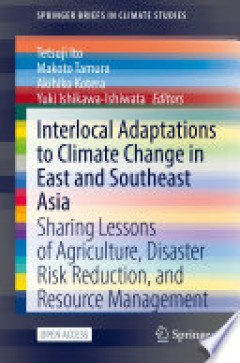Filter by

Interlocal Adaptations to Climate Change in East and Southeast Asia: Sharing …
This Open Access book’s main focus is agriculture and natural resource management, disaster risk reduction, and human resource development in the countries of East and Southeast Asia and Japan. Asia is one of the regions which is the most vulnerable to the impacts of climate change. More than sixty percent of the world’s people live in the region, making it the growth center of the world. A…
- Edition
- 3
- ISBN/ISSN
- 9783030812072
- Collation
- v, 164 p
- Series Title
- 164
- Call Number
- 363.73874095

Chapter Catastrophes, the Imaginary and Citizenship : The Production of the O…
This article reflects on the relationship between the media and the construction of publics, taking these to be based on identities and the processes of creating identities activated in concrete, well-defined contexts. This relationship, which is complex and defined by power dynamics, allows spaces, processes of citizen-ship, and the visibility and invisibility of causes, projects and trajector…
- Edition
- -
- ISBN/ISSN
- 9783110553079
- Collation
- 16
- Series Title
- -
- Call Number
- 363.342.MEN

Catastrophes, confrontations, and constraints: how disasters shape the dynami…
A ground-breaking study on how natural disasters can escalate or defuse wars, insurgencies, and other strife.Armed conflict and natural disasters have plagued the twenty-first century. Not since the end of World War II has the number of armed conflicts been higher. At the same time, natural disasters have increased in frequency and intensity over the past two decades, their impacts worsened by …
- Edition
- -
- ISBN/ISSN
- 9780262545556
- Collation
- -
- Series Title
- -
- Call Number
- 363.3 TOB c

COVID-19, The Global South And The Pandemic’s Development Impact
EPDF and EPUB available Open Access under CC-BY-NC-ND licence. This book examines the unique implications of the pandemic in the Global South. With international contributors from a variety of disciplines, it investigates the pandemic’s effects on development, medicine, gender (in)equality and human rights among other issues. The book’s assessment offers a discourse on the ways in which the…
- Edition
- -
- ISBN/ISSN
- 9781529225679
- Collation
- -
- Series Title
- -
- Call Number
- -

COVID-19, THE GLOBAL SOUTH AND THE PANDEMICS DEVELOPMENT IMPACT
EPDF and EPUB available Open Access under CC-BY-NC-ND licence. This book examines the unique implications of the pandemic in the Global South. With international contributors from a variety of disciplines, it investigates the pandemic’s effects on development, medicine, gender (in)equality and human rights among other issues. The book’s assessment offers a discourse on the ways in which the…
- Edition
- -
- ISBN/ISSN
- 9781529225655
- Collation
- xv, 224p.
- Series Title
- -
- Call Number
- 362.1962414091724 COV m

Re-imagining Japan after Fukushima
"The 2011 Tōhoku earthquake, tsunami and Fukushima nuclear disaster (collectively referred to as ‘3.11’, the date of the earthquake), had a lasting impact on Japan’s identity and global image. In its immediate aftermath, mainstream media presented the country as a disciplined, resilient and composed nation, united in the face of a natural disaster. However, 3.11 also drew worldwide atten…
- Edition
- -
- ISBN/ISSN
- 9781760463540
- Collation
- ix, 163 p.
- Series Title
- -
- Call Number
- 952.04 MIH r

Case-based decision support for disaster management
Disasters are characterized by severe disruptions of the society’s functionality and adverse impacts on humans, the environment, and economy that cannot be coped with by society using its own resources. This work presents a decision support method that identifies appropriate measures for protecting the public in the course of a nuclear accident. The method particularly considers the issue of …
- Edition
- -
- ISBN/ISSN
- 9783731509929
- Collation
- xvii, 295 p.; ill
- Series Title
- -
- Call Number
- 658.47 MOH c

Covid-19 Pandemic, geospatial information, and community resilience: global a…
Geospatial information plays an important role in managing location dependent pandemic situations across different communities and domains. Geospatial information and technologies are particularly critical to strengthening urban and rural resilience, where economic, agricultural, and various social sectors all intersect. Examining the United Nations' SDGs from a geospatial lens will ensure that…
- Edition
- -
- ISBN/ISSN
- 9781003181590
- Collation
- xxvi, 532p.: ill.
- Series Title
- -
- Call Number
- 614.4 COV c

Disasters and history : the vulnerability and resilience of past societies
Disasters and History offers the first comprehensive historical overview of hazards and disasters. Drawing on a range of case studies, including the Black Death, the Lisbon earthquake of 1755 and the Fukushima disaster, the authors examine how societies dealt with shocks and hazards and their potentially disastrous outcomes. They reveal the ways in which the consequences and outcomes of these d…
- Edition
- -
- ISBN/ISSN
- 9781108569743
- Collation
- x, 231p. : ill.
- Series Title
- -
- Call Number
- 363.3409 DIS d

Advancing culture of living with landslides: volume 1 ISDR-ICL sendai partner…
This book is open access under a CC BY 4.0 license. This volume contains peer-reviewed papers from the Fourth World Landslide Forum organized by the International Consortium on Landslides (ICL), the Global Promotion Committee of the International Programme on Landslides (IPL), University of Ljubljana (UL) and Geological Survey of Slovenia in Ljubljana, Slovenia from May 29 to June 2, 2017. T…
- Edition
- -
- ISBN/ISSN
- 9783319594699
- Collation
- XXVI, 586 p.
- Series Title
- -
- Call Number
- 551.307 ADV a
 Computer Science, Information & General Works
Computer Science, Information & General Works  Philosophy & Psychology
Philosophy & Psychology  Religion
Religion  Social Sciences
Social Sciences  Language
Language  Pure Science
Pure Science  Applied Sciences
Applied Sciences  Art & Recreation
Art & Recreation  Literature
Literature  History & Geography
History & Geography